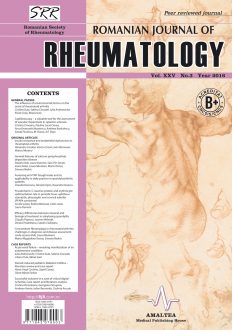SELECT ISSUE

Indexed

| |

|
|
|
| |
|
|
|

|
|
|
|
|
|
| |
|
|
HIGHLIGHTS
National Awards “Science and Research”
NEW! RJR has announced the annually National Award for "Science and Research" for the best scientific articles published throughout the year in the official journal.
Read the Recommendations for the Conduct, Reporting, Editing, and Publication of Scholarly work in Medical Journals.
The published medical research literature is a global public good. Medical journal editors have a social responsibility to promote global health by publishing, whenever possible, research that furthers health worldwide.
Steroid-induced pediatric diabetes mellitus – literature review and case report
Alexis-Virgil Cochino, Sigrid Covaci and Oana-Maria Farkas
ABSTRACT
Glucocorticoids (GCs), one of the principal drug classes used in rheumatology, are known for their fast onset and powerful action, but also for their multiple adverse effects, the most feared ones being osteoporosis, steroidinduced diabetes (SID), cardiovascular diseases and, in children, the decrease of linear growth rate. Due to data scarcity, most SID treatment recommendations are not evidence-based. Using the minimum dose and shortest possible treatment are preventive measures generally recommended, which are frequently not followed, due to fear of GC-sparing immunosuppressive agents’ side effects (DMARDs). Physiologic dose splitting, whenever possible, can be efficient in preventing at least some of the GCs’ adverse effects, mainly the suppression of the hypothalamic-pituitary axis and SID. These are depicted by a case presentation, of a 12-year-old female patient with SID caused by high dose GC treatment for juvenile dermatomyositis (JDM), in whom this method was sufficient to control glycaemia.
Keywords: steroids, glucocorticoids, diabetes, dose splitting
